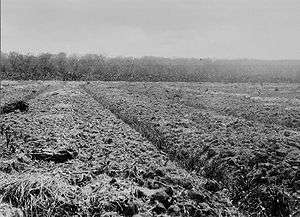Agriculture in Suriname


Agriculture in Suriname plays a secondary role in the economy, employing around 12 percent of the workforce. Only 0.4 percent of Suriname's total land area is cultivable, with half of this devoted to rice production, which makes up around 10 percent of Suriname's total exports, with 180,000 tons produced in 1999. The banana industry also accounts for 2.5 percent of total export revenues, with 55,000 tonnes (54,000 long tons; 61,000 short tons) produced in 1999. Suriname also produces palm kernels, coconuts, sugar, plantains, peanuts, beef, chicken and shrimp.[1] In the 18th century the production of coffee was of major importance under the Dutch colony but has gradually declined.
Since 1945, the Commission for the Application of Mechanized Techniques to Agriculture in Suriname has successfully brought new land under cultivation and redeveloped old plantations and improved the total agricultural production. Under union pressure, the government in early 1987 agreed to a national sugar plan to make production more efficient, and to create employment. The sugar industry is of major note in Guyana, especially the operations of Guyana Sugar Corporation since 1976, with 90,000 tons produced in 1999.[1]
Fishing, especially for shellfish, is also important with wild-harvest shrimp accounting for US$29 million, or 6.7 percent of all exports in 1998 and the fishing industry overall creating annual revenues worth US $40-50 million.[2] In October 2000, the industry was disrupted when a ban was imposed on Suriname's aquaculture products because of high levels of toxic residues.
References
- 1 2 Nations Encyclopedia
- ↑ CARICOM Archived January 27, 2010, at the Wayback Machine.